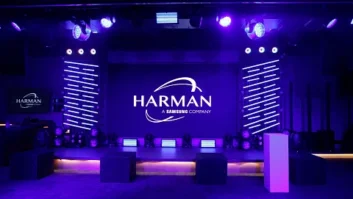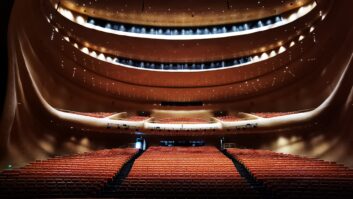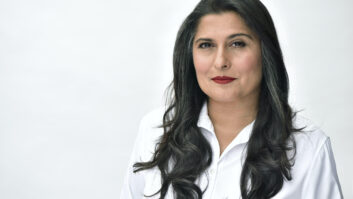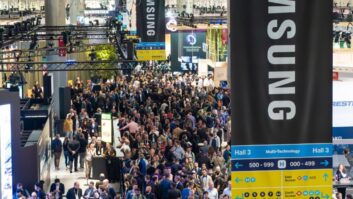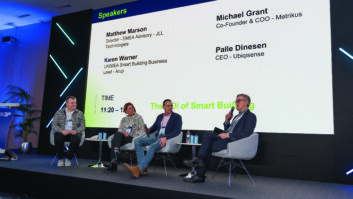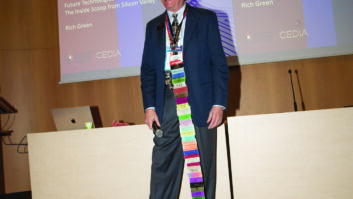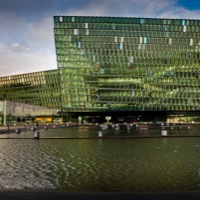
A world-class facility opened recently in the Icelandic capital, featuring a wealth of AV and lighting technology and a high degree of integration. Paddy Baker paid a visit.
In recent years, Iceland has attracted international media coverage for two main reasons. The first is the country’s contribution to the music world; it certainly punches above its weight, given that its population (just under 320,000) is comparable to that of a single city, or even a large town.
Iceland’s other recent claim to fame – or perhaps notoriety – was the role played by its banks in the global financial crisis in 2008. As it happens, both are significant in the story of the genesis of the Harpa concert hall and convention centre, which overlooks Reykjavik’s harbour.
The venue opened in May 2011, and has seen performances by perhaps the country’s best-known musical export, Björk, as well as the Iceland Symphony Orchestra and the Icelandic Opera, to which it is now home, and other international attractions such as jazz pianist Jamie Cullum and classical conductors Gustavo Dudamel and Maxim Vengerov. But when national bank Landsbanki crashed at the end of 2008, when the building was an empty four-storey shell, that might have been the end of the Harpa story. Fortunately the Icelandic State and the City of Reykjavik, which had been partners on the project since signing the contract in 2002, agreed that the development must continue. Construction started again in February 2009 after a halt of just a few weeks.
Exton, one of Iceland’s leading audiovisual companies, was hired as a consultant on the project by Portus, the company in charge of the development. Exton partner Sverrir Hreidarsson explains: “Our task was to make sure that the final result was not only consistent with what was asked for, but also that it was a viable solution for our local market. We continued as consultants working with Portus and with Artec Consultants [a New York-based firm specialising in performing arts spaces]. Then in 2007 we stepped down from consultancy and Harpa started creating the tenders for the job.”
Long-term plan
In 2008, Exton successfully bid for the tenders for sound and communication and production lighting. It was the only company that bid for both, something that Exton founding partner Kristjan Magnusson believes this was crucial: “We put a lot of emphasis on it – we said, you should select one contractor to work with not just on these bids, but for the future, because he will be involved in developing the building for the next 10 years. The system we have designed is very integrated: all the control systems are integrated into touchpanels, for example. It’s much harder to do this if you have separate contractors, and you also have the possibility of finger-pointing [over whose fault something is]. So we made it financially interesting for them to have one contractor for both – offering them a nice discount. And it saved money for us as well.”
In 2010 the company won three additional tenders, for the AV systems, digital signage and additional production lighting – following the decision to house Icelandic Opera in the venue, alongside the Iceland Symphony Orchestra.
In purely financial terms, the Harpa project is about three times the size, in financial terms, of Exton’s next largest job (the Hof concert hall in Aykureyri in northern Iceland). The sheer scale of the project, and high degree of systems integration throughout Harpa, necessitated a large amount of planning to ensure the different systems work together properly, says Exton founding partner Gunnar Gunnarson: “For instance, IPTV is distributed right across the network, but you don’t want a problem in one hall to take down the whole system – so you have to plan for that.”
There are two separate IP networks throughout the complex: one for sound and communication (including AV), and one for production lighting. Gunnarson describes the latter as “relatively simple system connecting dimmers, desks and DMX nodes and house lighting control.” Overall, there are 275 IP addresses within Harpa.
There is a high level of systems integration throughout the complex, with many different systems communicating with each other, explains Magnusson. Within the main concert hall, for instance, he says: “We let the Ateïs voice evacuation system talk to the Galileo loudspeaker management systems via the AMX control system, and at the same time the Clear-Com intercom system comes into the same loop. So for that part of the building those four systems are all tied together.
“The same goes for the lighting system: the ETC consoles are talking to the architectural lighting control system which is also talking to the AMX system. It gives you another control layer on top of the control desks, so a novice operator can come into the room and switch on the lights for the symphony orchestra without there being a lighting desk operator on site. It gave us a relatively simple system to install, but very sophisticated controls.”
This was over and above what was specified in the tender, he adds. “The original tender was for discrete buttons for each circuit of lighting – except for what the lighting console controlled. We decided to follow the idea of having a completely integrated system. We had to persuade Artec that this was the way to go in the future. We had to push for it, but in the end I think they were happy with it.”
Braving the elements
There are four main concert/conference spaces at Harpa – named after the four elements of earth, air, fire and water – ranging in capacity from 195 to 1,800 people. The main concert hall is called Eldborg, which means ‘fire castle’ and is the name of a volcanic crater in the west of Iceland. Appropriately furnished in a bright red decor, the hall, which is the permanent home of the Icelandic Symphony orchestra, can seat around 1,500 people on four levels, and (depending on the production) additional seats behind and to the sides of the stage platform can be used to raise the capacity to 1,800.
The sound systems were designed by Kari Eythorsson, a former Exton employee who now works from San Francisco on a freelance basis, who I talk to by phone subsequent to my visit to Harpa. I start by asking him about a sentence on Exton’s briefing notes about him: “Do not dare ask him to use anything other than Meyer Sound.” As one might suspect, it was a tongue-in-cheek comment, but he generally does turn to the Californian manufacturer’s product first, based on a mixture of admiration and practicality. “I know Meyer Sound equipment like the back of my hand – I’ve used it ever since I started with Exton [at the end of the 1990s],” he explains. “They are an amazing company, with a lot to admire – both in terms of people that work there and the products that they make. They have been a good partner to Exton. Meyer Sound is mature in the Icelandic market – there is all the knowledge about their equipment and good spare parts inventory. Also it’s easy to rent additional equipment into the facility if need be.
“Having said that, there are a lot of other very admirable loudspeaker manufacturers out there, and they all deserve respect for having brought new things to the market. I would do shows with other gear than Meyer Sound!”
Artec had initially specified point sound sources – based on the work that Eythorsson and Exton founding partner Gunnar Gunnarsson had done in during the project’s consultancy phase.
Eythorsson explains: “We placed a bid that was exactly what the tender asked for, but we also did an alternative to that – we consolidated a lot of devices and made things simpler so that devices could be shared between the halls and so on. Probably the biggest parts of that pie were the speaker system and the mixer system. When we got the tender we said, ‘Let’s what else we can come up with.’ So we kicked it around a bit, talked to Meyer Sound, they came up with a proposal, that proposal was amended, and eventually accepted to be part of the project.
“We basically wanted to do something that was a bit different, using the latest available tools at our disposal,” he says. “Working in a space like this does have some challenges – of course the room is primarily designed for an orchestra, so it’s easy to make the case that a line array might not be the perfect solution. You do not have the horizontal control that you would have from a point-and-shoot speaker system – that was the main challenge.
“For example, when you hang line arrays in a left and right configuration, if you have side balconies they are closer to the arrays than to the back of the hall that you are trying to cover as well.” How do you solve that problem? It’s to do with placement, he explains – placing the line arrays so that the balconies are in the area where the sound is starting to fall off – and also accepting that the SPL at the balconies must of necessity be a little higher than at the back of the hall.
The choice of equipment was relatively straightforward, he says: “There was a specified SPL goal and a coverage goal: we needed to reach a certain SPL figure in a uniform way around the hall, so the equipment basically specified itself from there.”
Permanent install
The Eldborg hall is the only one of the four main spaces within Harpa to have a permanently installed speaker system – and even that is winched away out of sight for acoustic concerts. The sound reinforcement system in Eldborg is built around three clusters of Meyer Sound loudspeakers. Flown left and right clusters consist of 10 Meyer Sound MICA curvilinear speakers, with five 600-HP subwoofers flown behind them; a flown centre cluster, covering the entire hall, comprises eight MICA cabinets, seven CQ-2 speakers for side- and downfill, one UPA-1P speaker for downfill and two CQ-1 cabinets covering the chorus balconies behind the stage. Seven UPJunior speakers, recessed in the stagelip, and another four in the balconies, provide auxiliary fills, as do another two CQ-2 boxes for stacked left/right frontfill and image pull. Loudspeaker processing is carried out by a Meyer Sound Galileo system.
For acoustic concerts, the speaker clusters, which hang from motorised winches are pulled up out of sight. A concealed announcement system, consisting of Tannoy Q-Flex units and recessed ceiling speakers, is used when the line arrays are not in use. In addition, a portable monitor system can be brought into the hall as needed.
Audio mixing and distribution is handled by the largest installed Midas and Klark Teknik digital network in the world – based around four networked Midas PRO9 live audio systems. Ingvar Jónsson, technical manager of sound engineering at Harpa, explains: “We are usually running the PRO9s as front-of-house, monitor and recording systems. We often use 60 or 70 channels, almost filling up the 80 channels available on each system. There are usually two companies recording, the national radio broadcaster and Studio Syrland, a local recording studio, which is usually multitracking, using the Klark Teknik DN9650 network bridge from AES50 to MADI. We also have a Klark Teknik DN9696 high-definition audio recorder, and we often multitrack the Iceland Symphony Orchestra with that.
“When we have a high channel count, one of the PRO9s is used as a premixer with the portable rack, then we have a FOH, monitor and recording console.”
In a fortunate bout of timing, Exton was able to specify the PRO9 before it had been officially launched; its channel count was sufficiently high for the venue’s requirements. “The original system we looked at would have already been outdated when we opened the house this spring, so the decision to go with Midas was a really good one,” comments Jónsson.” From a user point of view, the Midas system has been completely reliable since we opened.”
Chamber music
The hall’s acoustic design was carried out by Artec, and uses a number of techniques to vary the hall’s acoustic behaviour. By far the most significant is the use of external reverberation chambers, which can almost double the space by operating the 99 motorised concrete doors that connect the chambers to the main hall.
“We haven’t had as much time as we would have liked to work with the chambers, so we are still figuring out how best to use them,” admits Jónsson. “We are aiming more at low-frequency absorption, rather than high-frequency, because the curtain will take care of that down to about 500Hz.”
Eythorsson says he was surprised by how these chambers behaved: “When you think about using amplified sound in these kinds of spaces, your intuition says you want to have the least amount of reverberation in the room. These chambers are designed to increase the volume of the room and so increase the reverberation. But what we found was that we did not get the best results when the doors were closed. When you listen to, say, the sound of a kick-drum in the room, and the doors to the chambers are adjusted by increments of one degree, it’s quite amazing what it does to the sound. It’s like you’re tuning the room around the PA.
“My intuition said that these things would work either closed or open, but it doesn’t work that way. If you go from 20º to 21º to 22 – suddenly you have a tight kick drum. And then you go to 23, 24, 25 – it’s loose again! It was absolutely mind-boggling to me – it was the biggest surprise in the project – how powerful a tool these mechanical controls are.”
Other mechanical means of varying the hall’s acoustic behaviour are the use of motorised banners inside the hall and in the reverberation chambers, whose position can be adjusted; and a 10-tonne canopy, in two sections above the stage, which can be raised and lowered.
Gunnarson describes the lighting setup in the halls: “Production lighting is based on ETC dimmers and sensors. For house lighting control we have the ETC Paradigm, and an AMX interface for the 19in touchscreens, that’s communicating on Ethernet between the systems. The Paradigm sends feedback into the AMX that levels have been changed, and mimics that on screen. Then we have the lighting desks on the same network, and they can control the house lighting as well.”
“The lighting system is basically as Artec described it, except that we used AMX as a user interface instead of dedicated buttons. We have the AMX system turn on different modes in the halls – to lock out entry stations and things like that.” This approach provides greater versatility in operation; also, says Gunnarson, it’s easier to change an AMX user interface (using software) than to change dedicated buttons.
In the Eldborg there is an ETC Congo lighting console, which can handle 6,000 channels (with an ETC Congo Light Server for back-up). An ETC Wireless Focus Remote handheld unit and an ETC Remote Video Interface control allow control and programming respectively to take place away from the console.
For stage lighting, there are 480 dimmer channels, plus a further 168 non-dimming channels. Among the 290 fixtures are ETC Source Fours, ADB Warps, Selecon Aurora cycs and Robert Juliat Aramis followspots. In addition, there are 34 Martin TW1 and 32 Martin MAC III Performance moving heads. There’s also a 20,000-lumen Barco FLM HD 20 projector – one of three in the complex.
As might be expected in a building of this size, there is a digital signage system mainly in the public areas, comprising around 40 screens. This is used for wayfinding and room identification, as well as to promote forthcoming events, special offers in restaurants and the involvement of sponsors. Each screen has its own AMX-branded SpinetiX player. “We put in a control layer on top of that to handle the scheduling, which uses software from Stinova,“ explains Magnusson.
The signage system is in some ways complemented by the IPTV system. An AMX IPTV system takes streaming video from encoders in each of the halls and distributes it around 36 screens, distributed mainly in backstage areas, dressing rooms and offices. Any of five streams can be selected on each display.
During my visit to Harpa, I’m lucky enough to attend two very contrasting concerts in the Eldborg Hall: a Christmas concert by Icelandic group Frostrosir (the Frost Roses), featuring orchestra and choir, which shows the Meyer Sound system off to great effect; and a performance of Handel’s Messiah, using only the hall’s natural acoustics. Both sounded great – which just shows how a well-designed auditorium and a well-designed sound reinforcement system can be mutually beneficial.
www.adblighting.com
www.allen-heath.com
www.amx.com
www.ateis.com
www.barco.com
www.clearcom.com
www.da-lite.com
www.etcconnect.com
www.exton.is
www.gerriets.com
www.harpa.is
www.martin.com
www.meyersound.com
www.midasconsoles.com
www.robertjuliat.fr
www.stinova.com
www.tannoy.com
